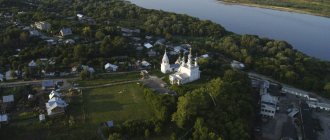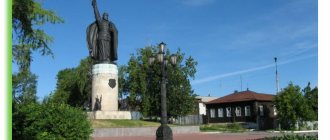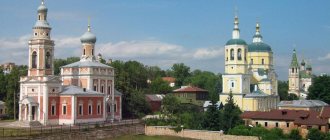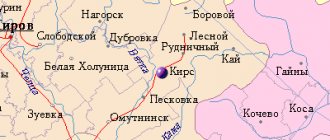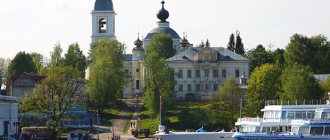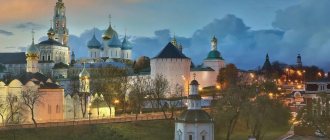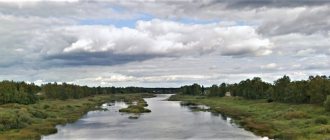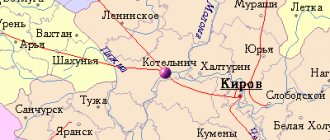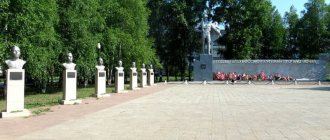Murom is one of the ancient cities of Russia. It appeared on the map in the 9th century. A lot has changed since those times. But Murom managed to preserve its historical appearance - merchant estates, golden-domed churches and Orthodox monasteries.
Historians believe that Murom is the birthplace of the legendary hero Ilya Muromets. According to ancient legends, the epic hero was born in the village of Karacharovo. Now it is already part of modern Murom. For this reason, attractions with an epic theme are often found on the streets of the city. In the city center you can see a monument to that same Ilya Muromets.
What to see first in Murom
Oksky Park
You will be surprised, but Murom does not have its own Kremlin. The powerful fortress that protected the city from attacks has not survived to this day. By order of Catherine II, the fortress was demolished. In the middle of the 19th century, Prince Trubetskoy built a city boulevard on the site of the Kremlin.
Now on the site of the Murom Kremlin there is Oka Park. Here locals love to walk and go on rides. By the way, it is in the park that there is a monument in honor of the hero Ilya Muromets. And if you love beautiful landscapes, then this is the best observation deck of the Oka River.
Address: Pervomaiskaya street, building 8
Moscow street
If you find yourself in Murom, then you must take a walk along Moskovskaya Street. This is one of the oldest streets in Murom. It appeared on the city plan in 1788. According to the new urban plan, stone buildings began to be built here.
Many buildings from the 18th and 19th centuries have survived to this day.
As soon as you get outside you are transported several centuries back. At that time, trade was actively in full swing on the street. There were drinking establishments, shops and restaurants.
Since those times, practically nothing has changed on Moskovskaya Street. There are still cafes and shops here, only they are equipped in a modern way. In addition to modern life, you can see ancient shopping arcades and reconstructed merchant shops here.
Address: Moskovskaya street
Holy Trinity Convent
There are many temples and monasteries in Murom. There are several monasteries that you should visit during your trip to the city. One of them is the Holy Trinity Convent.
This is one of the recognizable monasteries in the city. It was built in the Russian pattern style. But this is not the only thing that made the monastery famous. The relics of Saints Peter and Fevronia, the patron saints of family and love, are kept here.
In front of the Trinity Cathedral there is a monument in honor of the saints. All newlyweds in the city come here. According to local belief, if a marriage takes place in Murom, it will help strengthen and preserve family relationships.
Address: Krestyanina Square, building 3A
Spaso-Preobrazhensky Monastery
Another must-see monastery is the Spaso-Preobrazhensky Monastery. It is believed to be one of the oldest buildings in the city. The first mention dates back to the 11th century. Most likely, the building was previously used as a defensive structure.
Over the long years of its life, the monastery has experienced many things, from attacks to closure during the Soviet period. Now the monastery is operating again and is open to the public. Here you can try delicious monastery bread and enjoy the views of the Oka River.
Address: Lakina street, building 1
Water tower
Probably every city has famous residents. One of these in the city of Murom is mayor Alexei Ermakov. He built the first water tower in the city.
According to legend, Ermakov saw a woman climbing a mountain and carrying heavy buckets of water. This is how the idea came to build a water tower to make life easier for ordinary people.
The tower operated until the end of the 20th century. But later it was closed because the river water did not meet sanitary standards. Now the tower supplies clean water from artesian springs.
Address: Sovetskaya street, building 13
Moore
Video: Murom
Basic moments
Today this small city in the Vladimir region has just over 110 thousand inhabitants. Murom is located 137 km from the regional center of Vladimir. It is distinguished by its special charm, demonstrating to the admiring tourist the wealth of golden domes and the solidity of ancient buildings. “Whoever has not seen the city from the Oka has not seen Russian beauty,” Maxim Gorky said about Murom. This is a place of folk epics and legends, priceless architectural monuments of different times. Once here, it’s as if you find yourself in a real fairy tale, the plot of which takes us many centuries ago, to the times of the Old Russian state. The city is considered the birthplace of the famous epic hero Ilya Muromets, the defender of his native land, whose personality has long been his calling card.
The fates of twenty Orthodox saints who distinguished themselves by their mercy, piety, and fortitude are closely connected with Murom, so this is a special place for true believers. It is not surprising that thousands of pilgrims strive to get to the praying monasteries and churches.
Lenin Street
Moskovskaya street
Story
Monument to Ilya Muromets
The first mention of Murom is found in the “Tale of Bygone Years” by Nestor the Chronicler and dates back to 862. This significant date is considered “the beginning of the Russian state.” According to one version, the city received its name from the ancient Finno-Ugric tribe that previously inhabited these regions. In ancient Scandinavian literature the city is described under the name Muromar. The shipping route from the steppe to Europe passed through it, and the majestic city captivated passing foreigners with its beauty.
The Slavs came to these picturesque places at the beginning of the 9th century. The first ruler to come to Murom from Kyiv was Gleb, the son of Prince Vladimir. He ruled for 17 years, from 988, and was killed, according to various versions, either by his brother Yaroslav the Wise or by the soldiers of Svyatopolk. Gleb and his brother Boris became the first Murom saints.
The sad pages of history are associated with the transition of the townspeople to the Christian faith. After the Baptism of Rus' in Murom, for a century, residents still continued to worship pagan deities. At the end of the 11th century, Prince Constantine arrived from Kyiv with his wife, two sons, clergy and the miraculous icon of the Mother of God. He intended to strengthen the Orthodox faith, but his son Michael died at the hands of hostile pagans.
According to legend, an icon that began to glow helped convert the townspeople to Christianity. Constantine carried out a mass baptism of the inhabitants, the prince and his sons were later canonized. The relics of the saints today are in the beautiful Annunciation Monastery.
Murom more than once became the center of military battles with the Polovtsy and Volga Bulgars. The city was burned by the Tatars in 1239. The Time of Troubles lasted until the middle of the 16th century. After Ivan the Terrible’s successful military campaign against Kazan, the borders were pushed east, and a period of restoration and prosperity began in Murom.
In the 17th-19th centuries, the city acquired great commercial importance, as it was located at the crossroads of trade routes. Crafts actively developed in Murom, especially weapons and leatherworking. There was a whole settlement of tanners in the city; special wells were built for soaking raw materials. Local residents successfully made soap and wove canvas.
Panorama of Murom in the mid-17th century from an engraving by Adam Olearius
Agriculture also flourished. A funny historical fact is the story about bribes with seeds (including the famous cucumbers) that were given to officials. Empress Catherine II herself liked the baked goods and confectionery products of local craftsmen. The most delicious Murom sterlet on a stick was delivered directly to Her Majesty’s court.
The heyday of merchant Murom came in the 60s of the 19th century, largely thanks to Alexei Vasilyevich Ermakov. He came from Chelyabinsk, became rich and became a merchant of the first guild. He was elected to the post of mayor three times, and during his six years of work he managed to leave a memory of himself for centuries.
Ivan Kulikov. Fair in Murom (1910-1912)
Moore in 1975
The Ermakov family was rich, but childless. The mayor directed not only energy, but also personal capital to the improvement of the city. Under him, a theater was built, a telegraph was installed, and a water supply system was laid. The Ermakovs opened a hospital, a shelter for children and a library in Murom. The water tower (1864), built at the expense of the mayor, has survived to this day.
Soviet times were marked by the destruction of priceless historical monuments; the magnificent Theotokos Cathedral, the main decoration of Murom, the St. Nicholas-Mozhaisk Church, the Church of the Nativity and many others were wiped off the face of the earth.
Location and climate
Murom Bridge
Murom is located on the border of the Vladimir and Nizhny Novgorod regions. The city is picturesquely located on the high bank of the Oka, the length along the left bank is about 8 km. The distance to Moscow in a straight line is about 230 km.
The geographical location makes the city an important railway junction. Suburban trains connect Mur with Kovrov and Arzamas. The journey to Nizhny Novgorod by express train takes six hours.
The temperate continental climate provides warm summers and frosty winters. Spring in Murom is often short and cloudy, and autumn is characterized by frequent heavy rains. Snow usually lasts from late November to March. The greatest amount of precipitation falls in summer.
Winter Murom
Ferry crossing across the Oka River
Sights of Murom
At the entrance to the city from Vladimir there is an epic stone. Murom, as mentioned above, is considered the birthplace of the legendary hero Ilya Muromets; many monuments, exhibitions and festivals are associated with him. Historians still argue about the reality of the character and the place of his birth.
But local residents and tourists do not doubt the veracity of epics and legends. On Priokskaya Street (this is the former village of Karacharovo) on house No. 279 there is a commemorative wooden plaque. According to legend, about 900 years ago, in a hut located on this site, in the family of the peasant Ivan Timofeev, the famous strongman was born. Until the age of 33, he could not control either his arms or his legs, and subsequently he was cured of his infirmity by either the Magi or the Kaliki passers-by (as in the old days they called the wanderers who told epics and sang spiritual songs).
Peasant Square in Murom
Central square of Murom
After gaining miraculous power, the epic hero blocked the river with uprooted trees. The Oka changed its course and protected the village from enemy invasion and robbers. The size of the trees can be judged by the powerful oak rhizomes recently extracted from the bottom of the Oka. It is kept in the courtyard of the Historical and Art Museum. The hero, who became the hero of many epic stories (“Ilya Muromets and the Nightingale the Robber”, “Ilya Muromets on the Falcon-Ship”, “Ilya Muromets and the Robbers”, “Ilya Muromets and the Son”), also became famous as a defender of the weak and disadvantaged compatriots.
He was also known as a deeply religious man, who built a church and ended his glorious journey within the walls of the Kiev Pechersk Lavra. The name of the hero is included in the Orthodox calendar. Particles of the saint’s relics are kept in many churches in the city, including in the chapel at the Trinity Spring. The appearance of the source is associated with this legendary character himself. According to legend, he killed a heroic horse from under the hooves. Today a complex with fonts, canopies, a worship cross and a chapel has been built here.
The operating Spaso-Preobrazhensky Monastery stands on the banks of the Oka, located on the site of the courtyard of the first Murom prince Gleb. It is one of the most ancient not only on Murom land, but also on the territory of Russia. The first mention of the building dates back to 1096. Today the complex occupies a large, well-kept area with buildings, churches, and a beautiful cathedral. The monastery has a bakery, its own pond and a living area.
Spaso-Preobrazhensky Cathedral of the 16th century
Trinity Cathedral Convent
On the territory of the Holy Trinity Monastery, which is very popular among tourists, there are buildings from the 17th-19th centuries. Here is also one of the most revered shrines by believers - the Vilna reliquary cross. The monastery also preserves the abbot's building (dating from the 17th century) and walls with towers from the 17th-19th centuries. The wooden church of St. Sergius of Radonezh, built in the eighteenth century, is also located here. It was moved to the territory of the monastery from one of the surrounding villages. It operates only in the summer, gathering a considerable number of believers under its dome.
Nikolo-Embankment Church
Thousands of pilgrims come to venerate the relics of the princes of Murom, Saints Peter and Fevronia, the main Orthodox patrons of marriage and family. The story of their touching love was written in the middle of the 16th century by Ermolai Erasmus. The prince chose a poor pious girl as his wife. The nobility opposed the unequal alliance, and Peter went into voluntary exile with his beloved wife. Later they were asked to return and reign over the city. They ruled in Murom at the beginning of the 13th century. The spouses are remembered as wise and pious rulers. In their declining years they took monastic vows and died on the same day. There is a monument to them in front of the monastery, where, according to established tradition, wedding ceremonies are held, during which the newlyweds make their deepest wishes.
To venerate the relics of Saint Juliana Lazarevskaya, the patroness of poor compatriots, believers come to the St. Nicholas Embankment Church, built in 1700-1717, style - Peter the Great's Baroque. A legend about the holy Bishop Vasily, expelled from Murom, is associated with this place. In the place where he began his journey, a healing spring began to flow. After this event, the Murom residents received the name “saints” for their cruel attitude towards righteous people. People call the church “Nikola the Wet”, and it is no coincidence. In the spring, the Oka often overflows, and the water comes up to the very walls of the temple. By the way, at its foot is the Nikolsky spring. Its water is considered healing. Also not far from the church is the chapel of Our Lady of the Life-Giving Spring.
An interesting story is connected with the Church of Saints Cosmas and Damian. It was built in 1565. According to the surviving legend, when Ivan the Terrible went with his army to conquer Kazan, he prayed at the relics of the Murom saints, and his tent was pitched here, which stood from July 10 to July 20, 1552. After the victory, the king sent the best architects to erect new stone churches instead of the old wooden ones. The best masterpiece of their work is still considered the Church of Cosmas and Damian, the same age as the Moscow St. Basil's Cathedral (1561). One thing is regrettable: the very beautiful sixteen-sided dome, whose height was 12 meters, has not survived to this day. It collapsed in 1868, the reason being old age and wear and tear. Nowadays the church is crowned by a tent erected in 2009.
Annunciation Monastery in Murom
Church of Saints Cosmas and Damian in Murom
The founding of the Annunciation Monastery is also associated with the name of Ivan the Terrible. In 1552, on his way to Kazan, the tsar stopped in Murom. He prayed here for victory and promised to build a monastery on the site of an old wooden church built under Prince Constantine. As a result, Kazan was taken, and a year later the Russian autocrat kept his word. At the same time, construction began on the Annunciation Cathedral, rebuilt in the 60s of the 17th century and now operating.
Tourists who come to Murom definitely strive to visit the Church of the Smolensk Icon of the Mother of God - and not only believers. It is very beautiful and fits harmoniously into the architectural ensemble of the city. Its building is quite young by historical standards; it was erected in 1804. Before this, on the site of the Novo-Kozmodemyansk Church (this is the second name of the temple) there was a wooden church, which was destroyed by fire.
Church of the Smolensk Icon of the Mother of God
Murom Historical and Art Museum
Monument to V.I. Lenin on the square of the 1100th anniversary of Murom
The Murom Historical and Art Museum occupies the premises of a former ancient mansion, which was owned by the Golubev merchants. The exhibition “Treasures of Ancient Murom”, opened in 2013, is dedicated to the history and culture of the city. Later, another exhibition appeared in the museum, it was called “The City and the Citizens.” In general, up to 15 exhibitions are held annually in its halls. At the same time, museum workers offer visitors educational programs of a wide variety of nature. One of the most popular is dedicated to the history of ballroom etiquette and the “language” of fans and gloves. Others introduce tourists to the works of Russian and foreign artists who wrote in the 17th-20th centuries. The museum also displays collections of antique furniture.
Among the outstanding city attractions, despite its “youth,” is the cable-stayed Muromsky Bridge, built in 2009. The Vladimir-Arzamas bypass road, which goes around Murom, passes along it. The length of the bridge is almost one and a half kilometers, width - 15 meters. The bridge rests on three main pillars like “three pillars”: one is located in the middle of the river, the other two are on each bank. The pontoon bridge that existed previously worked only in the summer, which created certain inconveniences for transport workers - in the cold season they had to cross the Oka by ferry. Interesting fact: in 2013, the Federal Road Agency of Russia summed up the results of the competition for the most beautiful bridge in the country, and according to the results of the popular vote, the Muromsky Bridge was awarded this honorary title. A corresponding information plate is installed on one of its supports.
Moskovskaya street in Murom
Monument to Murom Kalach
Recreation and entertainment
History buffs in Murom will enjoy a walk through the old town. This is the area of Lenin, Sadovaya, Moskovskaya streets. Ancient buildings from the 19th century have been preserved here. A distinctive feature of the houses is the use of stone for the construction of the first floors, and wood for the upper floors. It was believed that stone was a less beneficial material for human health. They worked on the first floor, and lived on the second and third floors.
It is noteworthy that the architecture of the old city dates back to the time of Empress Catherine the Great, from the end of the first quarter of the 19th century. After the Empress approved a new regular plan for the development of Russian cities, the crooked streets and dilapidated wooden fortresses of Murom were replaced by straight, wide streets with typical house facades.
Water tower
The architectural monument of the 19th century is the Trade Rows, built in the Empire style. Nearby is the famous water tower, for which the mayor A.V. Ermakov allocated his own funds in 1864. It is noteworthy that even in Vladimir and many large cities of Russia at that time there was no running water.
The water pump took water from springs and at the same time served as a fire tower. It was sent through wooden pipes from larch trunks to a reservoir, from where it was supplied to houses and 16 city fountains. At the base of the water pump there is a plaque with the biblical saying: “And let there be water on the mountains.” In 1974, the tower was restored; chimes were built into it, which played the famous song “On the Murom Path” every hour. Then, at the request of residents, the loud music was turned off.
In warm weather, you should definitely visit Oksky Park. Inexpensive attractions (80 rubles), alleys, and benches will appeal to families with children. The beautiful observation deck offers a panoramic view of the city. Here is a 21-meter monument to Ilya Muromets, built in 1999. The first cable-stayed road bridge in Russia across the Oka River is located nearby. Against its background, you can take spectacular photographs as a souvenir of your trip to Murom.
Bread room
Children will be interested in visiting the Bread Room on Radiozavodskoe Highway. The museum is located at the bakery factory. Regardless of age, guests enjoy decorating gingerbread cookies themselves using a pastry bag and learning how to make real glaze. You can take your work of art as a souvenir. On Maslenitsa and Christmas, fun master classes are held here, which end with a festive tea party.
Interesting exhibitions are presented by the Murom Historical and Art Museum. It is located in a three-story house, the former estate of the Zvorykin merchant family. The most famous representative of the dynasty was V.K. Zvorykin, the inventor of television. After emigrating to America, he created a cathode tube, living a long, eventful life.
Monument to Peter and Fevronia in Murom
The funds of the mentioned repository are based on the legacy of Count Alexei Sergeevich Uvarov. A native of Murom, he made an invaluable contribution to the development of science. The count conducted excavations on his country estate, discovered the first Paleolithic site of primitive man in Russia, and became the first chairman of the Russian Archaeological Society.
The family owned a rich library and priceless archaeological exhibits, which were handed over by the wife after the death of the count. The collection of paintings presented in the museum contained paintings by Polenov, drawings by Shishkin, and one of the sketches of Bryullov’s painting “The Last Day of Pompeii.”
An exhibition dedicated to the life of Ilya Muromets takes pride of place in the museum. Here you can see a sculptural reconstruction of the hero’s head, recreated by the anthropologist S.A. Nikitin.
Fans of active recreation will also find entertainment in hospitable Murom. In the Ice Palace, both children and adults can skate on artificial ice. Billiard clubs, bowling alleys, and the Oktyabr cinema invite guests to have a good time. In the central part of Murom there are numerous cafes, bars, and pizzerias. Many establishments offer set lunches at affordable prices.
Catering establishments
A huge number of attractions and existing opportunities for organizing meaningful leisure time make Murom a popular destination for tourists at any time of the year, and the owners of numerous catering establishments have long been focused on welcoming dear guests.
In particular, many cafes and coffee shops are located right in the historical center of the city, offering all visitors a rich menu, ranging from first courses to delicious desserts. The prices, I must say, are quite affordable.
Murom in winter
Local pizzerias clearly position themselves as Italian restaurants, since in addition to freshly prepared pizza (it costs 225 rubles), they also offer visitors other dishes of the national cuisine of the Apennines.
As for Murom restaurants, some of them “reincarnate” into ordinary canteens during the day, luring gourmets with quite attractive offers. For example, business lunches for only 140 rubles per person are very popular in Murom.
If you prefer gourmet food and entertainment, we recommend visiting restaurants with themed rooms. In the summer, family and friendly dinners on the open verandas, which offer magnificent views of the Oka River, are especially popular. Prices are also quite reasonable: from 400 rubles per person.
Public transport
Regular minibuses and buses run in Murom. The fare is 17 rubles. Taxi prices are moderate. Landing costs from 60 to 80 rubles. Further – from 15 rubles per 1 km.
Hotels and accommodation
Hotel "Murom Estate"
The fates of more than twenty Russian saints are connected with Murom, so the city is a popular place of pilgrimage for believers. On memorial days and church holidays, there are many tourists in Murom; it is better to book a hotel in advance. On other days, finding accommodation in the few hotels in Murom is not difficult.
In the city center and in close proximity to popular attractions, the cost of a double room starts from 2,500 rubles per night. In the vicinity of Murom, the same room in a comfortable hotel will cost 500 rubles less. The price includes: parking, internet, sauna. You can find hotels in the city center with shared amenities at more affordable prices - from 1,300 rubles.
Booking.com
What to bring as a souvenir
The famous Murom pastries have been famous since the time of Catherine II. According to legend, it was at the instigation of the empress that in 1787 the lower part of the city’s coat of arms was decorated with three golden rolls on a blue background. The azure field signifies not only the waters of the Oka, but also the purity of the thoughts of the city rulers.
Souvenir shop
Rolls of bread are sold in company stores and at monastery bakeries. Sprinkled with poppy seeds and sesame seeds, these confectionery products surprise with their sizes: from small to very large. The classic kalach is made in the shape of a castle.
In souvenir shops you can buy clay products: dishes, figurines of fairy-tale characters. Twist dolls are also in demand among tourists. This is not only a toy, but also a powerful amulet. There is a small shop next to the historical and art museum. Here you can purchase copies of ancient jewelry found on the territory of Murom as souvenirs.
Free souvenirs are also popular. The city is famous for its healing springs; many people bring spring water home. According to beliefs, a handful of soil from Murom gives a person heroic strength.
Interesting facts about Murom
- Murom, like Rome, is located on seven hills. A magnificent panorama opens from the high bank of the Oka, which attracted the attention of all travelers passing through the city. Back in the 17th century, the secretary of the Holstein embassy, Adam Olearius, who happened to be here on his way to Persia, managed to convey picturesque views on canvas.
- At the beginning of the 14th century, Murom began to play an important role in the politics of the Moscow state. During the reign of Ivan the Terrible, the city became an important strategic point - in 1552, in Murom, the king held a review of his army.
- Murom was once visited by such Russian monarchs as Catherine the Great, Paul I and Nicholas I. And all thanks to the city’s advantageous position on the navigable Oka River. On the occasion of the arrival of the top officials of the state, mass festivities were certainly organized in the city.
- In Murom in the middle of the 17th century, blacksmithing became widespread - Murom craftsmen were famous for their locks, keys, and door handles.
- One of the hallmarks of Murom is local rolls, which the townspeople have been baking since the 14th century. In the times of Peter the Great and Catherine, they could be bought in any bakery and tavern, and today - in and in monastery bakeries.
- Murom is proud of its famous natives. Twenty Heroes of the Soviet Union were born and raised in this ancient city. Murom gave the country many artists (the most famous among them is Ivan Kulikov), writers and artists. The famous football player Viktor Losev, a member of the USSR national team who won gold at the Olympic Games in Seoul in 1988, was also born here.
View point in the park
Port of Murom
How to get there
The most convenient way to get to Murom is by car. From Moscow you can get to the Vladimir bypass road along the M-7 highway. Then, according to the signs, to Murom. The distance is 318 km and will take about 6 hours.
The train and bus schedule for a traveler who wants to see the sights in one day is not very convenient. Buses from Moscow arrive at lunchtime or in the evening.
Trains depart from Kazansky station. If you leave the capital of the Russian Federation at midnight, the train will arrive in Murom around 5 am. The price of a ticket for a reserved seat carriage is from 1,100 rubles, for a compartment – from 1,850. Travel time is from four to five hours. The bus ride takes half an hour longer than the train ride.
What to see in Murom with children
Epic stone
As you already understand, the history of the city of Murom is directly related to epic tales. At the entrance to the city there is a huge stone that greets all guests of the city.
The stone looks solid. This is probably what the road sign for entering Murom should be like. The face of Ilya Muromets is carved on the stone. You definitely need to take a photo here!
Address: Vladimirskoe highway
Muromsky kalach
Murom is famous not only for its epic tales, but also for its rolls. In honor of this bakery product, a monument was erected in the city center.
In the 18th century, Murom became famous for its delicious rolls, which Catherine II herself enjoyed. After this, the empress approved the city's coat of arms with three rolls.
The monument to the kalach is located on the main street of the city. As soon as you take a photo with the main symbol of the city, you can try a real Murom kalach in one of the cafes.
Address: Lenina street, building 24
Museum "Bread Room"
And if you want to learn more about the history of the Murom kalach and try to make it with your own hands, then go to the Bread Room museum.
At the museum you can sign up for a 2 in 1 excursion - an acquaintance with the Murom kalach and a master class on making that same kalach. At the end you will have a tea party with rolls made with your own hands.
Address: Amosova street, building 48
Murom, Murom-town. Part 1
I read so much about Murom that it seemed like I knew the whole city inside and out. But the city drawn by my imagination turned out to be completely different. To others. I didn’t expect that it would be so composed of opposites, that it would be so different, so provincial-modern, so Orthodox-pagan, so rustically cozy, childish, sad, impudently naive and sweeping.
Murom is a soothing city. His provincialism is classic. Here there is the whole set for which almost every resident of a large metropolis is nostalgic: a wide transparent blue river framed by sandbanks and steep coastal terraces, there are cozy streets with apple orchards, lilac bushes and jasmine thickets, there are charming merchant and bourgeois houses, there are carved platbands with amazing signs from the ancient-pre-ancient past, there are carefree cats licking their paws, there are shopping arcades with grannies, there are four (!) monasteries, there is an overgrown Murom Cultural Park on the site of an old settlement, there are drunks on the streets, potholes on the roads, clean air and fresh river wind.
I thought that the main attraction of Murom were the monasteries. It turned out not quite so.
The main beauty of Murom is Oka. She exposed one of her banks - a velvet barrel - to the city, and it freely spread out on it. The river here is very wide and windingly steep. This means that the eyes cannot comprehend all this incredible beauty. The view here is amazing. It is the view of Water, Sky, Sun, Clouds hanging over the river, and small river ripples, crushing the reflections of the same clouds. Silky wind and green curly shores. Sand spit. Mother of pearl shells on the sand underfoot. Little fishermen carefreely dangling their legs on a pontoon bridge across the Oka. Adult fishermen in waders, disentangling shiny fish from a net. Near the bridge there is a pillar with marks of past floods.
Below is the Oka, above on the high bank is the city. If you stand on the embankment and look up, the monumental figure of Ilya Murom with his sword raised to the sky looks especially impressive. And in general, from below you can clearly see the domes of churches among the lush greenery, you can hear the happy squeals of children from the Oka Garden with carousels, you want to buy simple ice cream “as before” from a weather-beaten saleswoman who stands here on the embankment near a concrete wall with an inscription in large crimson letters "Mur" and the coat of arms of the city.
By the way, my husband, despite the fact that before the trip I hardworkingly and persistently slipped him various interesting printouts about Murom, looking at the city’s coat of arms, he seriously and bewilderedly asked me: “What kind of dumplings are these?” “What other dumplings! - I screamed, - these are Murom rolls! What are you doing!” Although, for the sake of fairness, it should be noted that if you look closely, it is difficult for an inexperienced person in culinary matters to notice the difference. 
We didn’t want to leave Murom. After we eagerly examined almost all the local attractions and even went to Karacharovo, there was a strong desire to finish the cultural program here and finally relax, namely, like all normal Murom residents, take your time, take a fishing rod, take a towel and wave on Oka.
“The ancient Murom-grad stands on the high bank of Mother Oka, immersed waist-deep in green trees, touching the white clouds with the helmet-domes of temples. And centuries do not age him.” Men's folk ensemble "Muroma".
“Whoever has not seen Murom and the Oka has not seen Russian beauty.” Maksim Gorky.
“Murom, Murom is a town, look, it’s all over the place, and it smells of the old lady, Mother Russia! Stand, hospitable brothers, on the sandy, right bank of the Oka River, opposite Murom itself - in front of us is the Oka River, and behind it the Murom bank is a steep mountain; The town of Murom stands on the mountain, unfolded, stretched out like a ribbon: it flaunts holy temples, golden domes...” Vladimir Dal.
A little about the road.
Our route: Moscow – Murom – Diveevo. From Moscow to Murom is about 300 km. But we decided to go to Murom via Vladimir. We left on Friday evening so that, after spending the night in Vladimir (~170 km), we could calmly leave early in the morning for Murom (~130 km), have time to see everything, have a snack, and in the evening move to Diveevo (~130 km) and stay there for 2 days. This stop-and-breathe maneuver seemed clever and reasonable to us, and we, pleased with ourselves, rolled off. We have provided for everything, except for one thing – traffic jams like those on the Gorkovskoye Highway, probably in the Moscow region, are rarely seen anywhere. Before this, our “cork” list was headed by Yaroslavskoye. Now Gorkovsky has the yellow leader’s jersey. How we got up right from the Moscow Ring Road - and that’s it, movement per hour is a teaspoon. The degree of our already nervous state was increased by calls from the unobtrusive and extremely worried about us service from the hotel in Vladimir, every half hour clarifying when we would arrive. We left at 8 pm and planned to arrive in Vladimir at about 11. We got daydreaming. Only to Balashikha (~30 km) we sawed for about 1.5 hours in the densest traffic, and the traffic began to dissipate only somewhere at the 80th (!) km from Moscow. At one o'clock in the morning, exhausted, hungry and tired, they fell asleep.
The road approaching Vladimir was uneven and full of “night mines” - our car turned into either a train carriage or a flying chariot. We were driving in the dark and quite smoothly, but suddenly the smooth asphalt surface abruptly changed to uneven, we began to shake and toss - “heavy-dumb” - and from the sounds there was a complete feeling that we were not driving in a car, but shaking in a reserved seat. And when we accelerated, finally breaking out of the traffic jam, and rushing into the night, then suddenly the car was thrown up, and we were literally hanging in the air - seconds of flight, a crashing landing - what was that? It turns out that we didn’t notice the railway tracks. All this was already happening when we were almost approaching the city.
Vladimirsky Dvorik Hotel (www.vldvorik.ru) was chosen very carefully. My husband eliminated all my options (“Vladimir”, “Orion”) and said that this is a new hotel, small, positioning itself as a VIP, in a quiet center, with a lot of amenities. Room price (2.8 thousand rubles).
Indeed, everything turned out to be at a decent level for Vladimir - the room had an LCD TV, waffle robes, slippers, a bidet and a hairdryer. The staff is very friendly. But there were 2 points that I want to find fault with. Our room (No. 1) was a stone's throw from the reception. Well, let's say, when your private space comes into such close contact with public space, it somehow tensed us up a little. Mutual audibility there is very specific. And then - they don’t have a cafe, so breakfast was brought directly to our room. A very decent ration, by the way, just like on an airplane. But it’s also somehow uncomfortable - I’m drying my hair, everything is scattered, and here a stranger is rushing with boxes. It would be better to wheel it in on a cart-table and leave it at the door. But, in principle, these are trifles. The hotel is really good and conveniently located. Who knows the city of Vladimir - “Dvorik” is located next to the hotel of the same name in the city, the bus and railway station, 5 minutes to the Assumption Cathedral.
We left Vladimir early in the morning. It took ~2 hours to get to Murom. On a two-lane road you won’t be able to accelerate much, and most importantly, you won’t be able to overtake – if there’s a tarantay with hay in front, then that’s it, or 30 km/h. or blind overtaking - there is a hilly area and the perspective is not visible. And also cows - three times local cows, lazily wagging their tails, proudly raising their horns, without losing their feminine dignity, slowly and in absolutely no hurry, crossed the road in front of us. It is believed that Murom is a city on 7 hills. Although, to be honest, we didn’t notice any special hills here, but the road from Vladimir to Murom is exactly like after the bombing. If it were not for the beauty of dense pine forests, marvelous blue lupine fields, extraordinary carved decorations on village houses flashing outside the car window, then I would immediately want to know in detail where on which roads the car tax of Russian law-abiding citizens is dissolved.
Moore. We've arrived. Our plans.
Well, finally, we are in Murom.
We passed the Epic Stone at the entrance - the face of Ilya Muromets made of cobblestones, passed the armored train Ilya Muromets, and at one of the intersections (on the right there is a red brick casino and cafe, and a little ahead diagonally the bus station - for reference) we turned left onto the main street of the city - Moskovskaya.
We have plans to see three monasteries , two of the Holy Annunciation and Trinity; and one Spaso - Preobrazhensky. As well as the Church of St. Nicholas the Mokroy , the Oka Garden on the site of an ancient settlement, the ancient Church of Kozma and Damian , and the village of Karacharovo . We spend one day in Murom, so we don’t stay at a hotel, we spend the whole day exploring the city, and in the evening we leave for Diveevo.
In general, what can you do in Murom in one day:
* feel the difference between the bustle of the metropolis and the unhurried rhythm of a quiet provincial town;
* breathe in clean, fresh and tasty air;
* admire the monasteries;
* drink water from the spring near the Church of St. Nicholas the Wet;
* walk around the city a little;
* spin on the carousel in the Oka Garden;
* stand on the embankment and look at the Oka River;
* buy Murom rolls;
* envy, as one should, from the bottom of our hearts, the lucky fishermen who fill their bags with a brilliant catch;
* and forget, forget, forget that there are problems and fuss somewhere.
So, our journey around Murom.
What to see in the vicinity of Murom
Village Karacharovo
Without a trip to the village of Karacharovo, your vacation in Murom will be incomplete. According to some researchers, the village of Karacharovo is the birthplace of the epic hero Ilya Muromets.
The house in which the hero himself lived, and the Trinity Church, which was also founded by Ilya Muromets, have been preserved here. There is also a spring here in honor of the hero. It is believed that the source appeared in the place where the hero’s horse hit the ground with its hoof. Don't forget to take a bottle with you to collect water from the source.
Address: Karacharovo microdistrict
